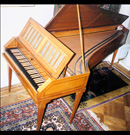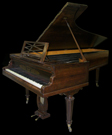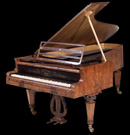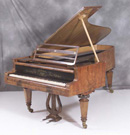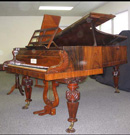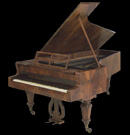Fortepianos & Squares
What exactly is a fortepiano? While there is no strict definition, the term has recently come to be used to refer to particularly early pianos and their replicas. Pianos called "fortepianos" are noticeably different from the relatively large and louder llate 19th and 20th century instruments most people comfortably recognize visually and aurally as pianos. Note that to confuse the issue, all pianos have been called "fortepianos" in some countries, and still are in some!
We have put into this category pianos notable for:
- Their earliness. In generally, fortepianos date from the 1700's to the 1840's.
- Their relative lack of metal and nearly complete reliance on wood for the structure. There may be a small bracing and a metal bar or two, but there will absolutely not be a cast iron frame.
- Their relatively light stringing and small hammers when compared with later pianos. Indeed, the very early example resemble harpsichords in sound more than they resemble pianos to some!. Almost always, fortepiano hammers are covered with leather, giving a very clean precise sound.
- We also include in this category replicas of or new instruments inspired by very early pianos.
Early Square pianos
I have placed my examples of early square pianos in the fortepiano category because they fit the criteria above beautifully, and because it is very important to NOT place them in the same bag as late 19th century square pianos. You will notice that we do not carry late 19th century square pianos. We choose to carry instruments which are a pleasure to own and that are good investments. I will say no more about large late 19th century square pianos.
Early square pianos were fabulously popular household instruments from the 1760's through the 1830's. Neither so space consuming nor expensive as grands and were a requirement for the homes of the growing merchant classes and the townhomes of the upper classes. Their sound is light and clean, perfectly suited to the parlor and perfect for accompanying the popular airs of the day or playing the sonatas of Haydn, J.C. Bach, or the other famous late 18th and early 19th century composers. Beethoven's arrangements of Scottish songs would undoubtedly have been popular volumes on the square pianos of London and the colonies of North America.

 Bösendorfer
Bösendorfer